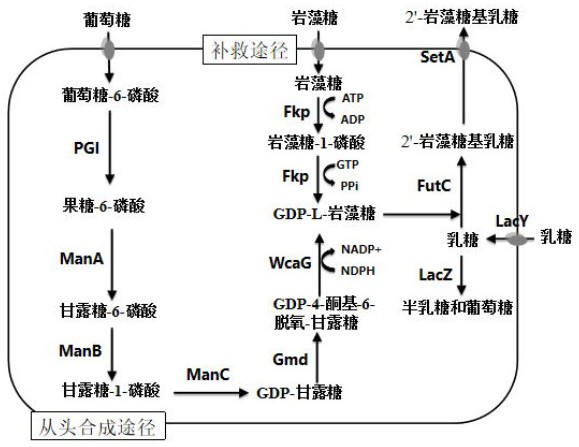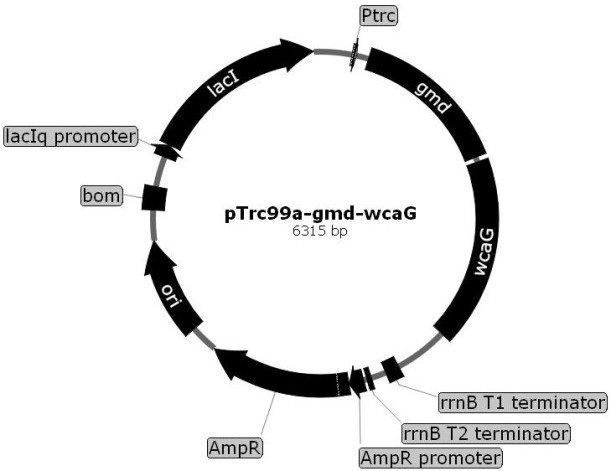Escherichia coli for producing 2'-fucosyllactose and application thereof
A technology of fucosyllactose and Escherichia coli, which is applied in the field of microbial metabolic engineering, can solve the problems of poor pathways, accumulation of intermediate metabolites, and high production costs, and achieve the effect of improving efficiency.
- Summary
- Abstract
- Description
- Claims
- Application Information
AI Technical Summary
Problems solved by technology
Method used
Image
Examples
Embodiment 1
[0046] Example 1: Strains E. coli K12 MG1655△ wxya ::Ptrc- wcaG-gmd-lacy build
[0047] Using Escherichia coli MG1655 as the original strain, knock out the Plac promoter sequence in the lac operon sequence and lacI, lacZ gene, and in lacI, lacZ Gene loci overexpressed using the Ptrc promoter wcaG, gmd, lacy Gene. The Ptrc promoter is a spliced promoter of the Ptrp promoter and the Plac promoter, and has higher transcription efficiency than the Plac promoter.
[0048] The method used to construct this strain is λRed recombination. The main purpose is to construct a two-step homologous recombination fragment, and use pKD46 (GenBank: MF287367) as a homologous recombination plasmid to carry out gene knockout and integration. The first step homologous recombination fragment contains upstream and downstream homology arms, chloramphenicol resistance gene and sacB Gene. The second-step homologous recombination fragment includes upstream and downstream homology arms...
Embodiment 2
[0058] Example 2: Strain W1△ adhE ::Ptrc- manB-manA build
[0059] for overexpression manB, manA gene, based on the W1 strain manB, manA Genome integration of , the integration site is selected as adhe (alcohol dehydrogenase) gene location. The gene integration method is consistent with Example 1. Need to construct the first step homologous recombination fragment adhe-cat-sacB . The required primers are adhe-up / adhe-2, adhe-down-FF / adhe-down, and Escherichia coli MG1655 is used as a template to obtain the upstream and downstream homology arms of homologous recombination by PCR. Construct cat-sacB gene fragments, of which cat is the chloramphenicol resistance gene, sacB Derived from pEX18Gm plasmid. Take three fragments, cat-sacB as well as adhe The upper and lower homologous arms of the gene are used as templates, and the first-step homologous recombination fragments are obtained by overlapping PCR. Construction of second-step homologous recombination ...
Embodiment 3
[0063] Example 3: Plasmid pTrc99a- futC-manC Construct
[0064] high copy overexpression futC, manC gene, need to construct plasmid pTrc99a- futC-manC . which was overexpressed using the Ptrc promoter f Gene, overexpressed using the arabinose-inducible promoter Para manC gene, so pTrc99a- f Plasmid and pKD46 -manC Plasmid, based on which pTrc99a- futC-manC plasmid.
[0065] pTrc99a- f Plasmid construction: Using the pTrc99a plasmid as a template, using primers ptrc99a-BA-R / ptrc99a-ty-F, PCR amplified to obtain a linear pTrc99a vector fragment containing a Ptrc promoter. Selection of fucosyltransferase genes from Helicobacter pylori f , using primers futc-11 / futc-12 to carry the total gene synthesis f The pUC57 plasmid DNA was used as a template, and PCR amplification was obtained f gene fragments, of which f Partial codon optimization of the gene, using seamless cloning enzyme to convert f Ligated with the linear vector pTrc99a fragment, the ligated...
PUM
 Login to View More
Login to View More Abstract
Description
Claims
Application Information
 Login to View More
Login to View More - R&D
- Intellectual Property
- Life Sciences
- Materials
- Tech Scout
- Unparalleled Data Quality
- Higher Quality Content
- 60% Fewer Hallucinations
Browse by: Latest US Patents, China's latest patents, Technical Efficacy Thesaurus, Application Domain, Technology Topic, Popular Technical Reports.
© 2025 PatSnap. All rights reserved.Legal|Privacy policy|Modern Slavery Act Transparency Statement|Sitemap|About US| Contact US: help@patsnap.com



